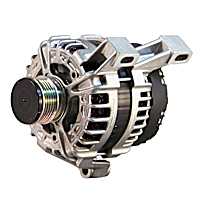You’re driving down the road, listening to your favorite song when, all of a sudden, the charging system warning light pops up on the dash. What does it mean? It’s just one of several symptoms that could point to a bad alternator. The symptoms of a bad alternator might also help you identify what went wrong.
Bad Alternator Symptoms
Powering your vehicle’s electronics isn’t solely the job of the battery. The alternator provides the necessary electrical power whenever your car’s engine is running. Plus, the alternator charges the battery at the same time.
Alternator operation depends on a phenomenon called electromagnetic induction. When the engine is running, the drive belt turns a pulley on the alternator. That pulley causes the rotor inside the alternator to spin, which, in turn, creates a magnetic field that induces an electrical current in the alternator’s stator windings. At the same time, field current flowing through a set of slip rings creates alternating magnetic poles on the rotor.

Because the magnetic fields are alternating, the alternator produces alternating current (AC). But there’s a problem: The battery and the rest of the car’s electrical system use direct current (DC). That’s why the alternator contains diodes, which are like electrical one-way check valves, to convert AC current into DC current.
If the alternator produces too little voltage, it will not be charging the battery properly. But if it makes too much voltage, the battery and electrical system may be damaged.
A voltage regulator manages alternator output to prevent overcharging or undercharging. The regulator may be located inside the alternator, or it may be a standalone component. On many modern vehicles, a computer (often referred to as the powertrain control module) regulates charging system output.
So, what are the symptoms of a bad alternator, anyhow? These are the most common:
Dim or Overly Bright Lights
An alternator (or a faulty external voltage regulator) that is overcharging can cause your car’s exterior lights to be overly bright. The bulbs may also burn out more quickly than normal.
On the other hand, an alternator that is undercharging can cause your car’s exterior lights to be dimmer than normal.
Dead Battery
A dead battery is one of the possible symptoms of a bad alternator. As mentioned earlier, the alternator charges the battery while it supplies the rest of the car with electricity. If the alternator is starting to go bad, it cannot charge the battery as efficiently. The battery then doesn’t store enough power for starting the car.

Alternator Noise
A whining or grinding sound coming from your alternator while your car is in operation is a bad sign. The noise usually indicates bad bearings inside the alternator.
Electrical Issues
Your car contains an array of electronics, all of which rely on charging system voltage. As such, a bad alternator can cause a myriad of electrical issues, especially on modern, computer-controlled vehicles.
Warning Lights
Depending on your car, a set of warning lights in your instrument cluster can warn you of impending failures. A light you should always watch for is the charging system warning light (AKA battery light), or the bright red warning light in the shape of a rectangular car battery.
Some vehicles even have “ALT” lit when the alternator is about to fail. This serves as the most obvious warning, indicating that it’s time for you to take your car to your trusted mechanic for repairs.
Also, without a proper voltage supply from the alternator, your car’s electronics, such as computers and sensors, won’t be working correctly. This can trigger the check engine light.
Vehicle Stalls
Many parts of your car—including fundamentals, such as the ignition and fuel systems—won’t work right without proper charging system voltage. This means they aren’t getting enough power from the alternator. As a result, your vehicle may stall while driving.

Trouble Starting Your Car
“How do I tell if my alternator is going bad?” is a common question that can yield different answers. For one, you’re likely to have trouble starting your car.
A faulty alternator will fail to charge the battery, which means you’ll likely have a hard time starting your engine. When turning the key in the ignition, you might notice an unusual clicking noise instead of the familiar sound of your engine running.
Smell of Burning Rubber
Over time, the alternator’s drive belt can wear due to constant tension and exposure to the engine’s hot temperature. Eventually, it’ll give off a foul smell of burning rubber.
The burning smell can also come from damaged wires. When too much electricity flows through the alternator’s wires, they tend to heat up. In severe cases, they’ll burn up and emit an unpleasant odor.
Malfunctioning Accessories
When your power windows or seat warmers respond slowly, there’s a big chance that your alternator is bad. A faulty alternator won’t be able to power your vehicle’s electronics, causing some of your accessories to work intermittently. In some cases, this can even include your speedometer and other gauges on your dashboard.
Most modern vehicles are usually programmed to prioritize certain electrical systems above others, which means your powertrain control module (PCM) knows which features to turn off first. For example, your radio is likely to go out first before the headlights stop working.
How to Tell If Your Alternator is Bad
Many symptoms of a bad alternator are also shared with a bad battery. Are you trying to determine whether the battery or alternator is to blame for your car problems? Here’s a quick and easy tip: try jumpstarting your vehicle. If you can jumpstart your car and it stays running, chances are, you’re dealing with a bad battery. On the other hand, if your car starts but dies shortly after, then your alternator may be faulty.
Have a Professional Test the Alternator with Dedicated Equipment
Of course, the “jumpstart” test isn’t conclusive. If you want a definitive answer as to whether your alternator is working properly, you’ll want to have it checked with a digital charging system analyzer or a carbon pile load tester.
Professional repair shops have such equipment, as do many auto parts stores. Best of all, most auto parts stores will test your charging system with the tool for free. You don’t even need to remove the alternator from your car—the tool allows for in-vehicle testing.
Check Charging System Output Yourself with a Digital Multimeter
The best way to test the alternator is with a charging system analyzer or carbon pile tester. But you can perform a basic charging system output test (using a digital multimeter set to DC volts) at home.
To test the charging system, connect the black meter lead to the negative battery terminal and the red meter lead to the positive battery terminal. With the engine off, the battery should have a base reading of at least 12.2 volts. Otherwise, the charging system test will not be accurate.
Once you’ve determined that the battery has a proper charge, start the vehicle and increase engine speed to around 1,500-2000 RPM. If the alternator is charging, generally, the reading on your meter should be around 13.5 to 15.0 volts with all of the lights and accessories turned off.
Consult a repair manual for the exact specification for your vehicle.
A reading that falls significantly outside of that range may indicate a problem with the alternator, regulator (if the regulator is external), or battery cables. A slipped or glazed serpentine belt could also be to blame.
Here’s a helpful video to show you how it’s done:
You can also check this video to get an idea of how alternators work:
What Causes an Alternator to Go Bad?
Most alternators fail due to time, miles, and use. There are, however, a few issues that can cause an alternator to fail prematurely.
Fluid Leaking on the Alternator
Leaking fluids are a common cause of early alternator failure. Engine oil or power steering fluid dripping down onto the alternator can cause it to malfunction early on.
Driving Habits
The way you operate your vehicle can also have an effect on your alternator. Say, for example, your vehicle spends a lot of time idling with many of the accessories (such as the lights) turned on. That can put an extra load on the alternator, causing it to create a lot of internal heat.
As a result, it may wear out prematurely.
Exposure to Moisture
Finally, an alternator that’s located near the bottom of the engine may be subject to water and salt intrusion. Both issues can lead to the component’s early demise.
FAQ
Can a car run with a bad alternator?
A car can only run for a short time with a failed alternator. The alternator charges the battery when the engine is running and, once the battery is depleted, the vehicle will die and fail to restart.
Driving a car with a bad alternator can damage several electrical components, such as the fuel pump, water pump, and power steering. Damaging any of these parts can cause several systems to fail and lead to an expensive repair bill.
How long does an alternator last?
An alternator is designed to last the life of the vehicle—but that doesn’t always happen. In some cases, the alternator may require replacement before the car is ready for the junkyard. That usually happens somewhere between the 100,000 and 150,000-mile mark.
Can you jumpstart a car with a bad alternator?
It’s possible to jumpstart a vehicle with a bad alternator as long as the vehicle’s battery still has some juice left. Unfortunately, once it starts, you’re running on borrowed time. As mentioned, once the battery runs out of power, your vehicle will stop running and not restart until a new alternator is put in.
Can You Replace a Bad Alternator Yourself?
If you’re handy with tools, you can replace a bad alternator. Some parts stores can even diagnose your faulty alternator while you wait at the counter.
A simple remove-and-replace operation can take a few hours though. Plus, if you aren’t confident in your abilities, you might cause more harm than good. Bring your vehicle to a professional mechanic if you want to play it safe.
Check out these videos on how to replace an alternator:
Find a Compatible Alternator For Your Car
It’s best to stop driving your car until you’ve replaced the faulty alternator. Otherwise, you might have to repair or replace additional parts like the battery, which relies on the alternator to charge its depleted cells. Good thing at CarParts.com, you can easily find an alternator that fits your application.
CarParts.com understands your need for compatible parts and accessories, so we’re happy to help you find the right alternator. Plug your vehicle’s year, make, model, and engine into our website’s built-in vehicle selector, and you’ll see our direct-fit products. Once you’ve found the alternator that meets your application, you can order on your mobile device in the comfort of your home. Our professional customer service team is available 24/7, so don’t hesitate to ask about our products.
For competitively priced alternators that you can rely on, look no further than CarParts.com. View our extensive selection of alternators and enjoy significant savings when you order one today.
Products Mentioned in this Guide
Any information provided on this Website is for informational purposes only and is not intended to replace consultation with a professional mechanic. The accuracy and timeliness of the information may change from the time of publication.



 Alternator
Alternator
 Battery
Battery





























